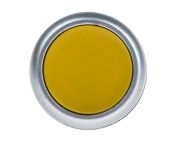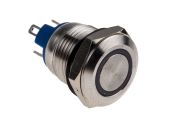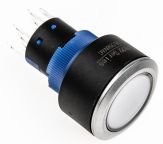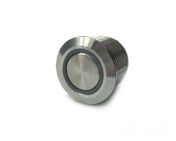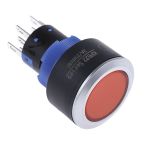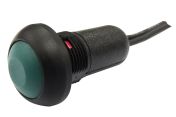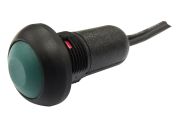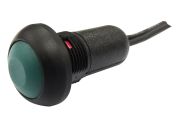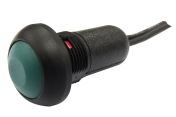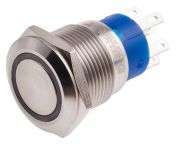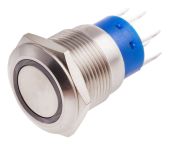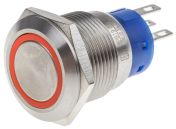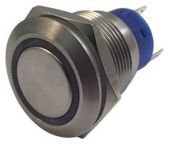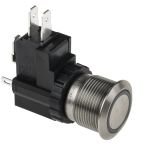Push Button Switches
Push button switches also known as push switches are one of the most common types of electrical switches used in the market today. These versatile components are used in a wide range of applications, from everyday household appliances to industrial machinery.
With their straightforward operation and robust construction, push buttons are a popular choice for controlling electrical devices, activating alarms, and initiating various control sequences.
Here at RS, we offer a comprehensive selection of high-quality illuminated and non-illuminated push buttons in a range of shapes, sizes, and colors. If you are designing a new project or simply maintaining an existing installation we are confident we have the right push button switch for you.
How Do Push Button Switches Work?
A push button has two main components, the button itself and the internal switching mechanism. When pushing the button, it forces the plunger to move, which in turn engages or disengages the internal contacts, thereby completing or breaking the electrical circuit. This type of switch is commonly known as a momentary push button, momentary switch, or momentary contact switch.
Types of Push Button Switches
Push button switches come in a variety of types, each with unique characteristics and features. Some of the most common are momentary push button switches, latching push button switches, and illuminated push button switches.
Momentary Push Button Switch
Momentary push buttons also known as spring return buttons are a type of switch that requires continuous compression. They will turn on when the user applies a force (usually your finger) to the switch button and will only stay on while the switch button is compressed. Once the force is removed momentary switches will spring back and return to their original off position.
Momentary switches will ALWAYS have brackets around the momentary position to help with identification. For example (On)-Off-(On), On-(Off).
Latching Push Button Switch
Latching push buttons, also known as maintained or stay-put push buttons are a type of switch that does not require continuous compression. They will turn on when the user applies a force (usually your finger) to the switch button and will remain in the on position. It is only until the user compresses the switch button again that the switch will not-latch and return to its original off position.
Illuminated Push Button Switch
Illuminated push buttons incorporate a light source, typically an LED, that lights up when the button is pressed. Illuminated switches are often used in low-light or dark environments and are ideal for applications where a visual indication of the switch's status is required.
Applications of Push Button Switches
Push button switches are widely utilized across various industries due to their versatility and reliability. In the automotive sector, they often serve as starter buttons to initiate engine ignition or control various in-car systems. Similarly, in the aerospace industry, these switches play a critical role in controlling cockpit functions and ensuring the operation of essential aircraft systems.
In consumer electronics, electrical push button switches are found in devices like televisions, computers, and home appliances, providing users with an easy interface for power and function controls. In industrial settings, industrial push button switches are essential for machinery operation, emergency stops, and process control, ensuring safety and efficiency in manufacturing and production environments. This broad range of applications highlights the crucial role push button switches play in modern technology and industrial processes.
Modern Use of Push Button Switches
In today's society, push button switches have found innovative applications beyond traditional uses. One prominent example is in push-to-start cars, where the push button starter switch replaces the traditional key ignition, providing a convenient and modern way to start vehicles. Additionally, push button switches are increasingly used in interactive public installations, such as kiosks, elevators, and interactive displays, enhancing user engagement and accessibility. These modern applications demonstrate the adaptability and evolving role of push button switches in contemporary technology and public infrastructure.
Choosing the Right Push Button Switch
Selecting the appropriate push button switch depends on several crucial factors to ensure optimal performance and reliability. Firstly, load requirements must be considered, as different push button switch types are designed to handle varying levels of electrical load. Understanding the voltage and current specifications of your application will help determine the right switch.
Environmental conditions also play a significant role in the selection process. For instance, switches used in harsh or outdoor environments need to be robust and weather-resistant to withstand factors like moisture, dust, and extreme temperatures.
Aesthetic considerations are important, especially in consumer-facing applications. The appearance, size, and feel of the switch should align with the overall design and user experience goals of the product.
Lastly, compliance with standards and regulations is critical. Ensuring that the push button switch types meet industry standards and certifications guarantees safety, reliability, and legal compliance in your specific application.
Push Button Switches for Sale on RS Philippines
Explore our extensive range of push button switches available at RS Philippines! From industrial push button switches to illuminated push button switches, we have the perfect solution for your electrical needs. Our catalog includes a wide variety of push button switch types to cater to different applications, whether you need a starter button, a momentary switch, or a latching switch.
Got special requests or a bulk order? Contact our customer support to discuss your needs!
